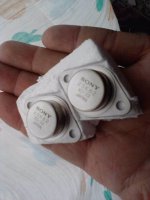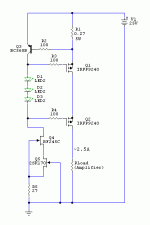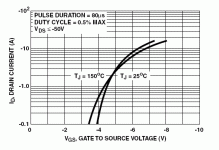I'm sorry I don't understand your question
it s good to laugh ............sometimes
 :
:Silly Question....
Hi Michael!
Some misconception for my part - I have found 120volt - 150Watt bulb(both internett & E-bay), but I started wondering: do we need 2pc 120Volt/300 watt i paralell per channel: That means we have 600Watt pr channel = 1200Watt pr. LÀmp? I have mine Alpair 10.2 in SelfMadeFonken which is Nominal= 6,1 ohm. So i have to keep down to around 8-10 ohm and 600Watt(bulbs + eventually resistors in combination) on each channel. Or can I keep it to around 10 ohm AND 300watt???
When I read the DeLite thread I think I saw 2 bulbs and each was 150 watt.
Hope you can give a clue to a somewhat novice in North Europe(Norway) - well been into electronic most of my life....
PS.
Mine 2SK82 KD33 arrived in the post Yesterday - Hurrah!!
So before I get the rest of the gear, heat sinks, trafoo and such...will be a project in the course of the spring!
Many thanks and blessed be to ye all in the New Year.
Olav
Hi Michael!
Some misconception for my part - I have found 120volt - 150Watt bulb(both internett & E-bay), but I started wondering: do we need 2pc 120Volt/300 watt i paralell per channel: That means we have 600Watt pr channel = 1200Watt pr. LÀmp? I have mine Alpair 10.2 in SelfMadeFonken which is Nominal= 6,1 ohm. So i have to keep down to around 8-10 ohm and 600Watt(bulbs + eventually resistors in combination) on each channel. Or can I keep it to around 10 ohm AND 300watt???
When I read the DeLite thread I think I saw 2 bulbs and each was 150 watt.
Hope you can give a clue to a somewhat novice in North Europe(Norway) - well been into electronic most of my life....
PS.
Mine 2SK82 KD33 arrived in the post Yesterday - Hurrah!!
So before I get the rest of the gear, heat sinks, trafoo and such...will be a project in the course of the spring!
Many thanks and blessed be to ye all in the New Year.
Olav
Hello Olav,
You're looking for around 10-13 Ohms. One 300W@120V bulb measures approx. 22 Ohms, so two in parallel are 11 Ohms. So, you need two 300W bulbs per channel.
You can use any combination of bulbs that gets you to 10-13 Ohms, or use a resistor.
BTW, a 6 Ohm, 87 dB speaker is really not going to be a good match for an amp like this.
8-16 Ohms, High Efficiency.
You're looking for around 10-13 Ohms. One 300W@120V bulb measures approx. 22 Ohms, so two in parallel are 11 Ohms. So, you need two 300W bulbs per channel.
You can use any combination of bulbs that gets you to 10-13 Ohms, or use a resistor.
BTW, a 6 Ohm, 87 dB speaker is really not going to be a good match for an amp like this.
8-16 Ohms, High Efficiency.
Last edited:
So, I have a reading comprehension type question. Great article by the way.
So, your bulbs drop a lot of voltage, along the lines of 25-40V. If you had a CCS which required a lot less voltage to operate then you could get away with a lot less B+ voltage. If I understand your table correctly, you only need 13.6V to 15.3V plus whatever it takes for the CCS to operate?
Now where did I put that old AudioXpress article...
So, your bulbs drop a lot of voltage, along the lines of 25-40V. If you had a CCS which required a lot less voltage to operate then you could get away with a lot less B+ voltage. If I understand your table correctly, you only need 13.6V to 15.3V plus whatever it takes for the CCS to operate?
Now where did I put that old AudioXpress article...
how to build or by a CCS with 3amp output ?
You may have a look into the Zen variations #9 where you can find a 2amp example.
http://www.firstwatt.com/pdf/art_zv9.pdf
Franz
You may have a look into the Zen variations #9 where you can find a 2amp example.
http://www.firstwatt.com/pdf/art_zv9.pdf
Franz
And a nice slow start reg.
thanks Franz , great article to read but definitly really not for baby member.. 
in few years perhaps..
nothing between a resistor and this?

in few years perhaps..
nothing between a resistor and this?
Last edited:
So, I have a reading comprehension type question. Great article by the way.
So, your bulbs drop a lot of voltage, along the lines of 25-40V. If you had a CCS which required a lot less voltage to operate then you could get away with a lot less B+ voltage. If I understand your table correctly, you only need 13.6V to 15.3V plus whatever it takes for the CCS to operate?
Now where did I put that old AudioXpress article...
Maybe a cascode Mosfet CCS with JFET cascode current source tail. Should bring very good HF PSRR. IRFP9240 will drop ~5V Vgs each at 2.5-3A region and will be sitting on their 0TC curves cross point. I.e. should be thermally very steady too. Dissipation will be 12.5-15W each. Current control formula is ICCS=VbeQ3/R1. 3 green LEDS ~2Vf can keep Q2 open too for that current region since their combined Vdrop>Vgs.
Attachments
Salas:
Thanks! I like that approach. I feel however that there is just too much voltage drop.
Here's the article I have been considering:
http://waltjung.org/PDFs/Sources_101_P2.pdf
The LM338K comes in a matching can to the Sony part and matches the simplicity of original the design quite well. Cannot get much more simpler than that, though who would have thought that low value trimmers aren't readily available (for adjustment targeting the 2-2.5A range)?
For a few extra parts, I'm considering trying Figure 16A, so I'd have the 1.25 V from the regulator plus 2V Vce for the BJT, which is still a good deal less heat than the circuit you propose and it seems to perform rather amazingly (granted, these results are at far lower currents).
Anyways, should be a fun little exercise. What do you think?
Thanks! I like that approach. I feel however that there is just too much voltage drop.
Here's the article I have been considering:
http://waltjung.org/PDFs/Sources_101_P2.pdf
The LM338K comes in a matching can to the Sony part and matches the simplicity of original the design quite well. Cannot get much more simpler than that, though who would have thought that low value trimmers aren't readily available (for adjustment targeting the 2-2.5A range)?
For a few extra parts, I'm considering trying Figure 16A, so I'd have the 1.25 V from the regulator plus 2V Vce for the BJT, which is still a good deal less heat than the circuit you propose and it seems to perform rather amazingly (granted, these results are at far lower currents).
Anyways, should be a fun little exercise. What do you think?
Less dissipation is a legitimate goal. I don't trust that much LM3XX chips for SQ though. What is one simple can outside, is a whole bunch of BJTs inside. But its an easy exercise to know if its open enough subjectively when feeding the SIT.
If you drop from ~50V supply to ~25V supply you will need half the previous transformer bulk obviously. Even less with just an LM338K as CCS.
I don't trust that much LM3XX chips for SQ though
well, more or less than say... a light bulb? 🙂 I think it's worth a shot. Seems to be in the spirit of the project.
Light bulb is just a glowing resistor with its own dissipation bubble. Minimal parts count, no metal sink, saves you turning up the lights to look for LPs.😀
From what I know in tube circuits, LM317 wasn't a nice cathode CCS for phase splitters, we used to go small BJT cascode and it was better. I wouldn't use it solo. Its attractive to drop just ~3.25V instead of ~10V at 2.5-3A assuming Fig. 16A. I am not a fan of TL431 chip either, but for high load impedance and good PSRR is surely an option to check out that combo, maybe it'll prove as good as anything here.
From what I know in tube circuits, LM317 wasn't a nice cathode CCS for phase splitters, we used to go small BJT cascode and it was better. I wouldn't use it solo. Its attractive to drop just ~3.25V instead of ~10V at 2.5-3A assuming Fig. 16A. I am not a fan of TL431 chip either, but for high load impedance and good PSRR is surely an option to check out that combo, maybe it'll prove as good as anything here.
P.S. If you will go power BJTs instead of Mosfets in my example CCS, the drop is going to be 2XVbe only, much less than 2xVgs. One Led will be enough too. Keep that as an option in mind.
Check this out gentleman:
http://www.diyaudio.com/forums/pass-labs/153832-pass-delite-amp-baf-60.html#post2503590
The ccs circuit was suggested by Papa. Bias current can be set by adjusting the 5k pot.
http://www.diyaudio.com/forums/pass-labs/153832-pass-delite-amp-baf-60.html#post2503590
The ccs circuit was suggested by Papa. Bias current can be set by adjusting the 5k pot.
- Home
- Amplifiers
- Pass Labs
- L'Amp: A simple SIT Amp


